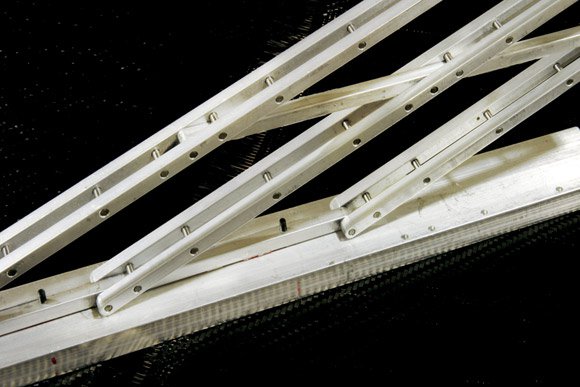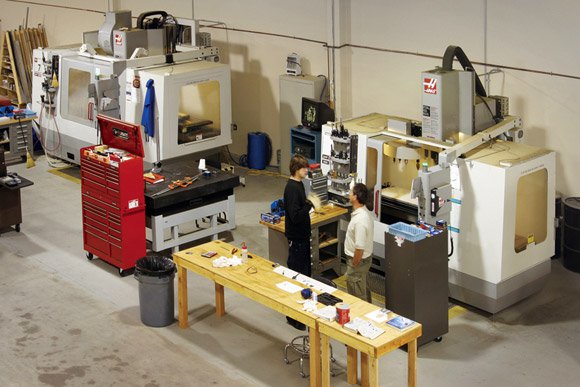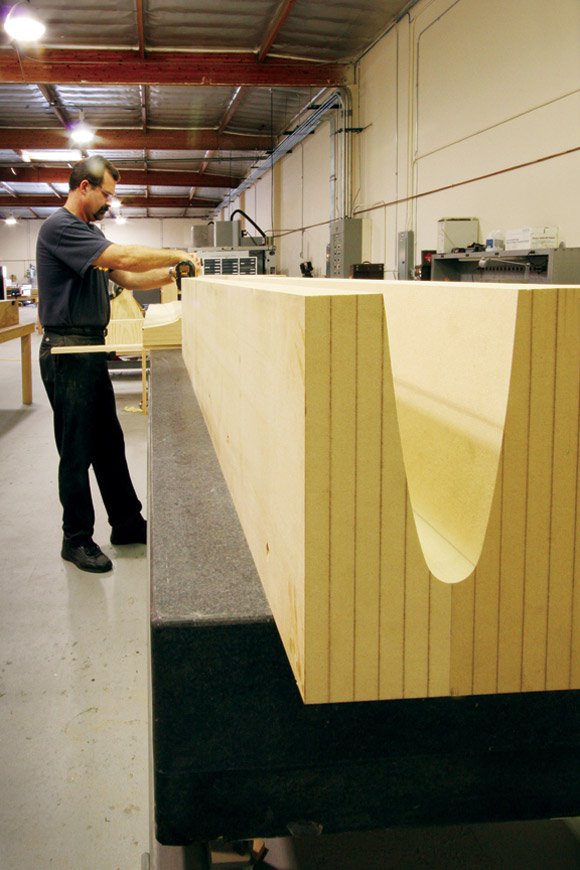The Flexible Shape Of Things To Come
The next generation of airplanes will look radically different, and so will the companies that create them.
Flexible Wings
It’s certainly not a new idea. More than a hundred years ago, two clever bicycle mechanics from Ohio used the concept to pioneer powered flight – and, admittedly, they stole the entire notion from the birds.
To the Wright Brothers, it seemed the only obvious plan: make a flexible airplane wing and change its shape to control flight. The idea worked, and made the Wrights successful where all others had failed. Yet, as aircraft speeds and wing loads increased, subsequent builders chose different means to control flight, and somehow, over the ensuing years, generations of aeronautical engineers forgot this earliest lesson.
But now, as if to celebrate the ironic spiral of technical evolution, this long-overlooked idea has been given an engaging new name – morphing – and christened today’s hottest topic in aviation research.
In defense of the great aircraft designers who have come and gone in the century since Orville and Wilbur, the task of constructing a modern airplane wing that is both strong, and flexible enough to change shape in flight, has been all but impossible . . . until recently. Thanks to advances in smart structures and active materials, the idea of significantly flexing and changing the shape of a working wing is finally becoming practical. While the materials and mechanisms to accomplish meaningful morphing are barely off the drawing board, the aircraft designer’s palette has undeniably changed forever. As you might expect, the U.S. Government’s aptly named Defense Advanced Research Projects Agency (DARPA) is pushing the boundaries of this research. In its recent Morphing Aircraft Structures program, the agency contracted three immensely talented aeronautical companies to design the technology and build proof-of-concept prototypes to pave the way.

DARPA was looking for flexible, shape-changing wings that could efficiently adapt to widely varying flight conditions – something even the best of today’s unbending wings can’t do.
Almost from the beginning of manned flight, hinged or sliding rigid panels, such as ailerons, flaps, spoilers and slats, have served as substitutes for a bird’s more subtle way of doing things. They’re adequate for the job, but far from aerodynamically perfect. Swing-wing concepts introduced in the ’60s offered a cautious step toward morphing, but the technology has remained tentative, and nowhere near as useful as hoped.
Essentially, the government was asking for a totally new technology. The Wrights managed “wing warping” back in 1903 to control steering in their first flyer. But in 2003, DARPA wanted a craft able to completely change its physical characteristics on the fly: transforming itself from an efficient, wide-winged, slow-soaring ranger into a narrow-winged, spectacularly maneuverable, high-speed bird of prey. Expected by-products of the technology, such as finer control, greater fuel efficiency and improved stealthiness, were anticipated as “research gravy.” If only DARPA could find the right group of researchers . . .
Flexible Companies
The talented contractors chosen to tackle this radical research were industry giants Lockheed Martin and Raytheon Missile Systems – along with a new and nearly unknown startup from Torrance, California, called NextGen Aeronautics.
Tiny by comparison, NextGen was nevertheless awarded a multi-million dollar contract, roughly on par with the others, and expected to perform in the same stellar league. DARPA was definitely thinking outside the box, but it knew what the pedigreed new team could bring to the table: flexibility.
“NextGen was formed for a reason,” says Fabrication Manager John Flanagan. “When you approach revolutionary research from within a big company, there’s no way to avoid getting caught up in the bureaucracy. You can’t stretch fast enough and you can’t jump far enough. You just can’t move as quickly as your brain works.” Research requires responsiveness. A small group is naturally more agile, and in NextGen’s case, deliberately more flexible.

Flanagan points out that the principals who formed the company were previously industry consumers of the same type of research products they now produce. “Our CEO was head of the flexible-wing project at Northrop Grumman. One of our board members was the first commander of the International Space Station, and another was a former NASA Administrator’s right-hand man.”
From past experience, NextGen’s managers understand the flexible approach required to give a client what he really needs – even if that client doesn’t always spell it out. “We know the surface finish the assembly guy expects; we know the extra steps needed to prep a model for wind tunnel tests,” says Flanagan. “We’ve been there. We bid the job that needs to be done, not just the minimum work required to meet the print. In the process, we save the customer time and money by eliminating the re-work that would inevitably follow. We become more than just a fabricator, we become a trusted team member.”
Flexible Thinking
“We’re successful in research for a reason,” observes Flanagan. “In this type of work, you have to use your brain all the time; and from the beginning, we were committed to doing exactly that.
“Our goal was to have everyone on the team capable of doing everything. We set out to attract open-minded people, because that was exactly the type of company DARPA wanted. Then, and now, everyone here is used to their fullest capability.” If a machinist needs a special fixture, Flanagan expects him to design it, program it and make it himself. In short, everyone’s expected to be flexible and adaptable to any situation.
“Down the road, we’ll be doing production,” he continues, “and we’ll expect those people to be as smart as the research guys. If a machinist can look at a part and figure out a better way to build it, he’s thinking to his fullest. That’s what we want.”
The goal of morphing technology is to use integrated sensors and actuators to their optimum capabilities, so a wing can sense its environment and flexibly adapt its shape in flight. Does this mimic the birds? “Well, that’s the goal,” admits Flanagan, “but we’ve got a long way to go. Birds are intelligent; they can sense a lot and they can adjust quickly. We humans are also very intelligent, and we have a lot of sensors, too. There are thousands of hairs on our arms, and every one of them is a sensor, but they’re obviously not as useful as a bird’s. We’ve figured out how to fly; now we have to figure out how to use machine sensors as fully and effectively as the birds use theirs.”
Flexible Fabrication
While flight sensors and actuators drive a lot of NextGen’s primary research, they represent only a fraction of the company’s range of activities. Prototype work extends to articulated wing structures, high-strength stainless-steel wind tunnel models, load-bearing antenna systems and complete proof-of-concept flight-test vehicles. While day-to-day shop work seldom follows a set routine, all the fabrications routinely begin on Haas Automation machine tools.
Highly adaptable Haas VF-4 and VF-7 vertical machining centers handle a remarkable range of milling jobs, and an unpretentious Haas TL-2 Toolroom Lathe sustains the turning. “These are good, solid machines that do everything we want them to do – without costing a fortune,” says Flanagan. “The whole point of using Haas machines is that we can quickly upgrade them as our requirements dictate.” He demolishes the myth that cutting-edge work demands ultra-elaborate machines. “Flexibility trumps complexity every time!” he exclaims. “Technology changes quickly, and will pass by the expensive built-for-30-years-of-production machine in the blink of an eye.”

NextGen seeks machine flexibility because the materials they use will surely change as the technology advances. Their current collection runs the gamut: from absolutely astounding to oddly ordinary. Specialized skins that can stretch and move, yet withstand flight loads, are probably the project’s biggest challenge. In response, NextGen has experimented with rare materials such as shape-memory alloys and memory-retention polymers. Yet, for the majority of their standard polyester and graphite skin fabrication, they machine molds from ordinary medium-density-fiberboard (MDF), better known as particleboard at the local Home Depot®.
“It’s a very rapid moldmaking technique,” says Flanagan, “and that’s what counts.” The shop laminates multiple 4 x 8 foot, 3/4-inch-thick sheets of MDF into whatever size blocks they need. Treating the block as a uniform solid, prototype designs are drawn in SolidWorks™, and toolpaths are generated in CAMWorks™.
The highest possible spindle speed and feedrate are used during the initial runs in the soft material, followed by a final pass at a slower feedrate with 10-thou’ stepovers for a perfect finish. Securing the MDF block to a vacuum table and carefully monitoring the humidity allows the shop to consistently maintain a 5-thou’ or better tolerance in the material.
“Some traditional guys tell us: ‘You’re crazy to cut that kind of stuff on your machines.’ But that’s the very reason we have these machines,” stresses Flanagan, “to be able to do everything we need to do, without worrying. We’re not a production shop. We don’t need to make a hundred copies a day. But we do need the capability to machine whatever we want, whenever we want it, however we choose to do it.”
The machinists control dust with a simple vacuum removal system, and turn out large, precision molds in a fraction of the time required by other approaches. After MDF work, they routinely switch to metal cutting with flood coolant on the Haas VMCs, with no problems whatsoever.
Since NextGen makes a lot of one-off items or matched left- and right-hand pairs, “Most of our stuff needs some kind of weird fixture for holding or matching,” says Flanagan. “We’ve developed lots of innovative, fast ways of doing that. Whether it’s vacuum tables, existing-bolt-hole jigs, adhesives, Bondo® or even barbells, we do whatever it takes to get the job done.”
While they carefully consider the cutting loads a part will see, they seldom worry about how they’ll mount it. It’s out-of-the-box thinking at its best – a non-traditional but flexible approach to solving an age-old problem. Flanagan remembers: “One of our new machinists said, ‘I wish I’d thought about glue-mounting before. It could have saved me half my work-time in the past!’” If talent and genius are givens, flexibility is what it’s all about. Flanagan feels that concept will be the future hallmark of the industry.
“It’s certainly not a new idea, but being able to react more quickly than the competition has gotten us the interesting work,” he says. What could be more fun than making morphing structures and flying like the birds? “There are a lot of fun projects out there,” he reminds us. “And, isn’t that the point of life?”




